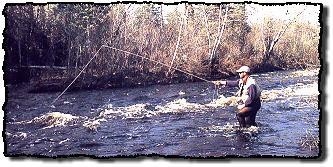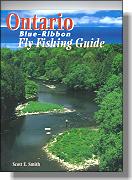Lake Superior Streams
By Scott E. Smith
Excerpt from: Ontario, Blue-Ribbon Fly Fishing Guide
Published by: Frank Amato Publications, Inc.
P.O. Box 82112, Portland Oregon 97282 Phone: 503-653-8108,
email Frank Amato Publications
The rivers and streams of the Ontario north-shore of Lake
Superior are what I refer to as my home rivers. They are
pristine, wild, rugged and mysterious; their tea-stained
pools beckon you to work with them with a fly. I am in
love with these rivers. To live the perfect life would
be to fish every day of the northern season from April
to December, plying the many streams of the north-shore; never
tiring of the variety of species and places to fish.
The majority of Superior's coastal streams are freestone
spate rivers of steep gradient; a product of the terraine
through which they traverse being the most rugged portion of the
Canadian shield. Giant mesa and questa rock formations tower
above Superior, sometimes 1000 feet above the lake. This makes
for some spectacular vistas along the Trans-Canada Highway,
which skirts the top of Superior, and some very rugged country.
The rocky terrain and swift currents of these rivers command
respect from all anglers. The spruce bog origins of these
tributaries dictate tea-stained, acidic water, reminiscent of
Canada's east coast salmon rivers. They are pristine and
unpolluted; having a relatively short run between the lake and
the first upstream barrier to migratory fish. These tea-stained
spate rivers are oligatrophic (non-fertile) in nature: Meaning
the acidic water is not fertile enough to support substantial
numbers of resident fish; hence reducing the amount of predation
on trout and salmon fry. This factor, combined with prevaling
gravel bottoms and clean, fast water percolating through the
tailout of pools and runs, completes the requirements for ideal
nursery habitat for a cornucopia of salmonids. Brook trout,
lake trout and whitefish are native to Lake Superior, but since
the turn of the twentieth century, rainbow trout (steelhead),
coho, Chinook and pink salmon have been successfully introduced
and have evolved into self-sustaining populations. Presently
no stocking occurs along Superior's Ontario coast. Some larger
rivers, such as the Nipigon and the Steel, attract a small
number of Atlantic salmon and brown trout that have been
introduced elsewhere on the lake, and because of more fertile
conditions host good populations of resident trout.

A study on steelhead in the 1990s - crafted by Ontario Ministry
of Natural Resources biologist Jon George - showed that some of
the rivers on the shore hosted steelhead that had spawned up to
six times. This relates significantly to a very healthy population
of wild steelhead. Interesting data also shows that rivers with
the most angling pressure, but also the highest rate of catch and
release - such as the Cypress and the Jackpine - have the highest
incidence of repeat spawners within the population. Jon George,
who has become renowned for his steelhead conservation efforts,
maintains that the key to keeping the populations healthly is
to keep it wild. In other jurisdictions on the Great Lakes,
domestic strains of rainbow trout have been aggressively stocked
to augment the wild population, and offset high harvest. The
lugubrious result, in some cases, is a population of impure
steelhead inadequate for Superior's rugged conditions, eventually
leading to a near collapse in the steelhead population in some
areas. The key, of course, in keeping the strain wild is minimal
harvest. George's study recommended a very low daily limit on
steelhead, while maintaining angling opportunities. This strategy
differed greatly from strategies in other jurisdictions where
seasons or rivers were closed in an act of frantic crisis
management.

Coaster brook trout that once thrived in most of the Great
Lakes maintain a foothold in Superior's north-shore tributaries.
Significantly in the Lake Nipigon-Nipigon River-Nipigon Bay (Lake
Superior) continuum, where it is still possible to catch a brook trout
of leviathan standing. "Coasters" is the regional name for the
migratory brook trout that thrive along Superior's coast most of
the year and ascend coastal rivers in late summer and early fall
to spawn. Many coasters attain trophy size - over twenty inches
and five pounds - and are eager to smash a passing fly. In past
centuries the harvest of these magnificent fish was tremendous,
if not ludicrous. As recent as the early 1900s, an angler was
allowed to possess five brook trout of any size in one day. This
translates (and often did) to five coasters totaling an aggregate
weight of twenty-five pounds. Persistent lobbying by angling
groups such as the Thunder Bay Fly Fishing Club, resulted in
the limit on large brook trout being reduced. However, an
earlier closing on the season and a liberal limit (5) on coasters
under twelve inches still presents a burr-under-the-saddle for
the general populace of fly anglers. Hopefully this management
strategy is replaced by policies with stronger conservation and
angling opportunity orientations.
More on Lake Superior Streams next time! ~ Scott E. Smith
Our Man In Canada Archives
|



